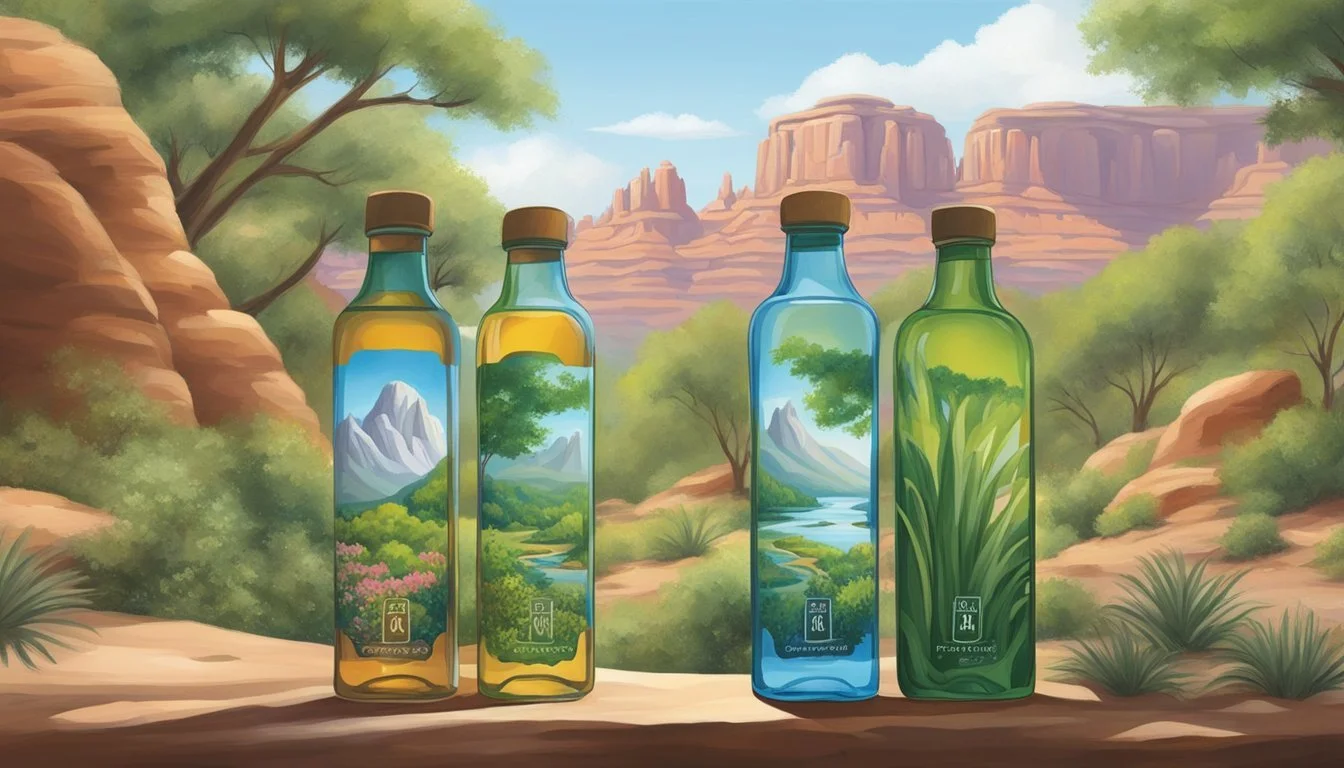Purely Sedona vs. Cirro
Which Bottled Water is Better? Analysis and Comparison
When evaluating premium bottled water brands, enthusiasts often compare options to find the best taste and value. Purely Sedona has garnered attention for its focus on purity and affordability, making it a popular choice among conscientious consumers who don't want to break the bank. With prices ranging from $1.50 to $3.00 per bottle, it's accessible without compromising quality.
Cirro, on the other hand, is distinguished by its pristine sourcing and slightly higher price point. Fans of Cirro appreciate its consistently refreshing taste and the brand's commitment to environmental responsibility. These factors often sway consumers who prioritize sustainability alongside hydration.
When directly comparing Purely Sedona and Cirro, the deciding factor often lies in individual taste preferences and budget considerations. While Purely Sedona offers cost-effectiveness and purity, Cirro delivers premium quality with an eco-friendly edge.
Understanding Bottled Water
This section dives into the origins, types, health benefits, and regulatory aspects of bottled water. It provides essential information to help you make informed decisions about water options.
Source and Origin
Bottled water can originate from various sources, including natural springs, artesian wells, and municipal supplies. Brands like Purely Sedona often source from natural spring water found in specific regions known for their purity, such as the French Alps or the Italian Alps. These origins impact the water's mineral composition and taste, influencing consumer preference. Some brands, like Cirro, may source water from multiple locations to ensure purity and consistency.
Types of Bottled Water
There are several types of bottled water available on the market, each catering to different needs and preferences:
Spring Water: Sourced directly from underground springs.
Artesian Water: Comes from an artesian aquifer.
Mineral Water: Contains natural minerals and meets certain mineral content criteria.
Purified Water: Undergoes additional purification processes.
Alkaline Water: Has a higher pH level.
Sparkling Water: Infused with carbon dioxide for a fizzy effect.
Still Water: Non-carbonated and smooth to drink.
Health and Hydration
Hydration is crucial for maintaining health. Bottled water often contains essential minerals and electrolytes that support bone health and muscle function. For example, mineral water provides a natural source of calcium and magnesium, while purified water ensures contaminants are minimized. Alkaline water has been marketed for its potential to neutralize body acidity. Choosing the right type of water can aid in optimal hydration and overall well-being.
Regulation and Safety
Regulation and safety of bottled water are governed by entities like the EPA. Brands must adhere to strict certification standards and undergo regular quality reports. For example, Purely Sedona's products are tested for contaminants and mineral content to ensure safety. Compliance with regulatory standards ensures that consumers receive safe and clean water, free from harmful substances.
Examining Purely Sedona and Cirro
Purely Sedona and Cirro are two popular bottled water brands that offer distinct characteristics, from mineral content to packaging. Understanding these differences can help consumers make informed choices based on their preferences and values.
Mineral Content Analysis
Purely Sedona features a mineral profile rich in calcium, magnesium, potassium, and sodium. This composition provides beneficial electrolytes that enhance taste and hydration. Specifically, the water includes:
Calcium: 25 mg/L
Magnesium: 10 mg/L
Potassium: 3 mg/L
Sodium: 5 mg/L
Cirro, on the other hand, emphasizes a low mineral content strategy. Its primary composition includes trace amounts of bicarbonate, calcium, and magnesium, focusing on a minimalist approach to minerals. This makes it appealing for those seeking a clean, light taste without strong mineral flavors.
pH Balance and Alkalinity
Purely Sedona boasts an impressive pH level of 8, categorizing it as alkaline water. The natural alkalinity is attributed to the Artesian spring source in Sedona, which is known for its balanced mineral content. This makes it highly beneficial for those who prefer alkaline water due to its perceived health benefits.
Cirro maintains a neutral pH level around 7. This pH balance aims to replicate the natural state of pure water, neither too acidic nor too alkaline. Consumers who prefer a neutral pH may find Cirro more appealing, as it aligns closely with the body's own natural pH balance.
Taste Profile Comparisons
The taste profile of Purely Sedona is often described as smooth and crisp, with a subtle mineral aftertaste. The presence of electrolytes such as calcium and magnesium enhances the overall flavor, making it a favorite among those who enjoy slightly mineralized water.
Cirro offers a different experience with its light and clean taste, free from any significant mineral aftertaste. This makes it ideal for consumers who prefer their water to be refreshing without the pronounced flavor of added minerals. The neutral pH and low mineral content contribute to Cirro's pure and straightforward taste profile.
Packaging and Environmental Factors
Purely Sedona is available in both glass and high-quality plastic bottles. Glass bottles are marketed as eco-friendly and recyclable, appealing to environmentally conscious consumers. The brand's commitment to sustainability is reflected in its packaging choices, although the use of plastic bottles does contribute to plastic waste.
Cirro prioritizes environmental sustainability through the use of 100% recycled plastic bottles. This focus on recycling and reducing plastic waste resonates with consumers who are concerned about environmental impacts. Additionally, Cirro's lightweight bottles reduce transportation emissions, further supporting its eco-friendly initiatives.
By examining these critical aspects, consumers can better navigate their choices between Purely Sedona and Cirro to find the bottled water that aligns with their health, taste, and environmental values.
Technical Aspects of Bottling
Purely Sedona and Cirro use different techniques in their bottling process to maintain water quality and brand reliability, addressing filtration, manufacturing, and labeling.
Filtration and Purification Processes
Purely Sedona sources its water from artesian springs in Sedona, Arizona. The water undergoes natural filtration as it passes through layers of rock and minerals. Artesian water is prized for its purity and mineral content.
Cirro employs advanced filtration techniques such as reverse osmosis and distillation to remove impurities. These methods ensure that the water is devoid of contaminants and retains beneficial minerals. The choice of filtration influences the final taste and quality of the product.
Bottling and Manufacturing
Purely Sedona's bottling process emphasizes environmental sustainability. The brand uses recyclable materials and energy-efficient machinery, minimizing the carbon footprint. They ensure the integrity of the water is maintained from the spring to the bottle.
Cirro focuses on high-tech manufacturing with strict adherence to quality control. The facilities employ automated systems to fill, cap, and label bottles, ensuring consistency. Both brands prioritize preventing contamination during bottling, using sterile environments and rigorous hygiene standards.
Labeling and Brand Reputation
Purely Sedona markets itself based on the mystical and healing properties attributed to the Sedona region. The labeling reflects a commitment to purity and natural sourcing, featuring detailed information about the water's origin and mineral content.
Cirro places emphasis on modernity and technology. Its labeling highlights the advanced filtration processes and clean water guarantee. Transparent labeling practices build consumer trust by providing comprehensive details about the treatment and purification stages.
Both brands leverage their unique brand reputations to appeal to different consumer preferences, with Purely Sedona focusing on natural purity and Cirro on technological advancements. This strategic differentiation allows each brand to target specific segments of the bottled water market effectively.
Comparative Analysis
Purely Sedona and Cirro both occupy distinct positions in the premium bottled water market. Purely Sedona is known for its affordability and local heritage, while Cirro focuses on broader appeal and accessibility.
Consumer Reviews and Preferences
Purely Sedona tends to attract budget-conscious buyers due to its lower price range, which varies from $1.50 to $3.00 per bottle. Consumers often praise its clean taste and local origins, adding to its appeal among those interested in regional products.
Cirro, on the other hand, is appreciated for its affordability and broader consumer base. While it may not carry the same local appeal as Purely Sedona, Cirro's competitive pricing makes it a popular choice for everyday hydration needs.
Key Points:
Purely Sedona:
Price: $1.50 - $3.00 per bottle
Known for clean taste and local heritage
Cirro:
Price: More affordable
Popular for everyday use
Market Position and Brand Visibility
Purely Sedona has carved a niche in the premium bottled water market with its focus on the purity and narrative of local heritage. This branding strategy has garnered it a loyal customer base that values regional identity and quality.
Cirro aims for a broader market presence, emphasizing affordability without compromising on quality. Its visibility is bolstered by strategic pricing and marketing campaigns that target a wide audience, making it a recognizable name in the bottled water sector.
Key Points:
Purely Sedona:
Focus: Purity and local heritage
Strong regional following
Cirro:
Focus: Affordability and broader appeal
Strategic marketing efforts
Sustainability and Environmental Impact
Both Purely Sedona and Cirro are branded as premium bottled water options.
Environmental Impact Bottled water production generates significant amounts of CO2. For every 50 oz produced, between 1.6 and 22 oz of CO2 can be released. This carbon footprint starkly contrasts with tap water, which has nearly zero CO2 emissions when consumed directly.
Sustainability Purely Sedona's sustainable practices are notable, especially in their choice of packaging. Meanwhile, Cirro's commitment involves efforts to reduce plastic usage through innovative bottle designs.
Plastic Waste The widespread use of plastic bottles remains a critical environmental issue. Cirro often uses high-density polyethylene (HDPE) and has introduced initiatives to encourage consumers to recycle. Purely Sedona, on the other hand, focuses on minimizing plastic waste by using lighter PET bottles.
Recycling While both brands promote recycling, the effectiveness varies. Cirro’s HDPE bottles are commonly accepted in recycling programs. Purely Sedona’s efforts include clear labeling to help consumers distinguish recyclable materials.
Metric Purely Sedona Cirro Carbon Footprint Moderate due to plastic use Moderate, uses lighter HDPE Plastic Waste Focus on lightweight PET HDPE with recycling efforts Recycling Clear labeling to assist HDPE widely accepted
By examining these differences, consumers can make more informed choices about their bottled water purchases.
More About Purely Sedona
Aqua Carpatica vs Purely Sedona: Which Bottled Water is Better?
Boxed Water vs Purely Sedona: Which Bottled Water is Better?
Castle Rock vs Purely Sedona: Which Bottled Water is Better?
Core Hydration vs Purely Sedona: Which Bottled Water is Better?
Hawaii Volcanic vs Purely Sedona: Which Bottled Water is Better?
Hawaiian Springs vs Purely Sedona: Which Bottled Water is Better?
Ice Mountain vs Purely Sedona: Which Bottled Water is Better?
Icelandic Glacial vs Purely Sedona: Which Bottled Water is Better?
Mountain Valley Spring Water vs Purely Sedona: Which Bottled Water is Better?
Nestle Pure Life vs Purely Sedona: Which Bottled Water is Better?
Poland Spring vs Purely Sedona: Which Bottled Water is Better?
Purely Sedona vs Cascade Mountain: Which Bottled Water is Better?
Purely Sedona vs Crystal Geyser: Which Bottled Water is Better?
Purely Sedona vs Crystal Lake: Which Bottled Water is Better?
Purely Sedona vs Essence pH10: Which Bottled Water is Better?
Purely Sedona vs Kirkland Signature: Which Bottled Water is Better?
Purely Sedona vs Liquid Death: Which Bottled Water is Better?
Purely Sedona vs Proud Source: Which Bottled Water is Better?
Purely Sedona vs Richard's Rainwater: Which Bottled Water is Better?
Purely Sedona vs Simple Truth: Which Bottled Water is Better?
Purely Sedona vs Talking Rain AQA: Which Bottled Water is Better?
Purely Sedona vs Weird Water: Which Bottled Water is Better?
Purely Sedona vs Whole Foods 365: Which Bottled Water is Better?
Purely Sedona vs Whole Foods Italian Still Mineral water: Which Bottled Water is Better?
San Pellegrino vs Purely Sedona: Which Bottled Water is Better?
Solan de Cabras vs Purely Sedona: Which Bottled Water is Better?
Zephyrhills vs Purely Sedona: Which Bottled Water is Better?






